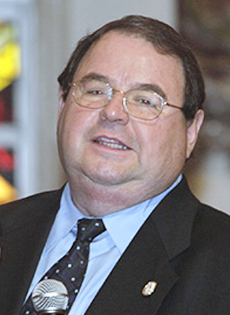
History of the Eucharistic celebration III: In Jesus' time
Monday, November 25, 2019
*Rogelio Zelada
The time for the sacrifice of the Paschal lamb had to be moved ahead from dusk to the beginning of the afternoon due to the centralization of worship in the Temple of Jerusalem and the extraordinary number of lambs that were to be slaughtered there. In the Eastern world, the day does not begin with the dawn, but at dusk, when celestial darkness allows a glimpse of a first star. Although the story of Exodus prescribes sacrificing the lamb at dusk, it was not possible to slaughter the animal, bleed it, prepare it for the fire and eat it on time. The High Priest carefully collected the blood of the lamb in the Cup of the Covenant and spilled it on the altar of sacrifice as an atonement for the sins of the people. An ingenious drainage system made the blood of the slaughtered lambs run to the Kidron Valley stream, which turned purple during Passover.
The Passover Supper of the Lord, on the eve of his Passion, developed according to the ancient blueprint of the meal that opens the Sabbath, with the rites, preserved by the Jewish Diaspora, remaining almost unchanged through the centuries. The supper space was always reserved only for the men, who were usually distributed in three groups, lying on the floor, on carpets, mats, or pillows, depending on the possibilities. In the center, a platform was used as a table where food was placed. Towards the top of the platform, the main guests lay down according to their greater or lesser rank or honor. The most important dinner guest was at the end, in the corner. The other guests followed him in decreasing range after the main one; on the other side, facing the most honorable guest, was the family that had invited or offered the dinner.
Participants’ legs were positioned somewhat apart from the body of the guest, so that a slave, the youngest son of the family, or the owner of the house himself could untie the sandals and refresh the feet of the guests as a sign of fine Eastern hospitality. It was customary to decorate the table with a tablecloth and take the opportunity to use different tableware. A very special family cup was reserved for this solemn occasion.
After the purification of the hands, everyone, already positioned around the table, shares the first cup: “Blessed are You, Lord our God, King of the universe, who creates the fruit of the vine.” Then, the father of the family, or whoever presides over supper, breaks bread and distributes it, a gesture that properly starts the meal: “Blessed are You, Lord our God, King of the universe, who brings forth bread from the earth.”
Also on the table are the platter with the roasted lamb, a dish with bitter herbs, another with unleavened bread and one with red sauce. Everything takes on a solemn atmosphere when the presider puts wine in the cup and mixes it with water, almost in equal parts to temper the alcoholic strength of the wine. With the cup of blessing in his hand, he thanks God, who ensures nourishment for all his creatures and has anointed Israel with the seal of the covenant and granted them land. This long prayer concludes with a supplication to sustain, keep and take care of them, and for Elijah and the Messiah, son of David, to come during their lives.
The large influx of pilgrims greatly reduced the spaces where the supper could be held. Availability varied: from a small terrace, a garden, a flat roof or a closed room for those who had the extraordinary opportunity to celebrate the great feast.
In this Paschal framework, the synoptic gospels have framed and collected the traditions that already existed when the sacred texts were written. They omit, on purpose, known aspects of the Jewish feast to focus the story on the words and gestures with which Christ institutes the Eucharist of the Church. The oldest narrative, of St. Paul to the Corinthians, appears to collect the same tradition of Luke’s Gospel where words about the bread —“This is my body”— are separated from “This is the Cup... ” by the other components of the meal.
The tradition of Mark and Matthew follows another custom of the primitive community: “While having supper, he took...” The Eucharist happens exactly in the middle of the fraternal agape, where everyone had brought something to share. It is after the evening of the Resurrection when everyone starts to use their senses in light of the post-Paschal understanding. Thus, the Risen Christ breaks the bread with the astonished disciples of Emmaus, and later, at the Lake of Galilee, he will summon them again to the table: “Come and eat.”
As a backdrop, the community remembers the meals shared with the Master, which contain glimmers of the Good News: The messianic meal in Cana of Galilee; the multiplied loaves in the middle of the desert; meals shared with sinners; the amazing meal of forgiveness at the house of Simon the Leper; the friendly and healing meal at Peter's house in Capernaum; the meal that strengthened the role of women at Martha and Mary's house, etc.
The Lord's Supper will preserve as a treasure the same blueprint and the words of the Master at the Last Supper. From his gestures of “taking, blessing, breaking and sharing” developed, in an improvised way but faithful to Tradition, each part of what today constitutes the sacred liturgy of the Mass —Presentation of the Gifts (he took), Eucharistic Prayer (he blessed), Fraction of the Bread (he broke) and Communion (he shared).

